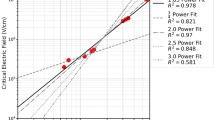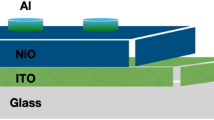Abstract
Electron beams of 0.5, 1.5, 2.0, and 5.0 MeV were used to irradiate n-Si diodes to fluences of 5.5 × 1013, 1.7 × 1014, and 3.3 × 1014 e cm−2. The forward voltage drop, minority carrier lifetime, and deep level transient spectroscopy (DLTS) characteristics of silicon p–n junction diodes before and after irradiation were compared. At the fluence of 3.3 × 1014 e cm−2, the forward voltage drop increased from 1.25 V at 0.5 MeV to 7.96 V at 5.0 MeV, while the minority carrier lifetime decreased significantly from 7.09 μs at 0.5 MeV to 0.06 μs at 5. 0 MeV. Six types of changes in the energy levels in DLTS spectra were analyzed and discussed.




Similar content being viewed by others
References
R.O. Carlson, Y.S. Sun, H.B. Assalit, Lifetime control in silicon power devices by electron or gamma irradiation. IEEE Trans. Electron Devices 24, 1103–1108 (1977). https://doi.org/10.1109/T-ED.1977.18884
B.J. Baliga, E. Sun, Comparison of gold, platinum, and electron irradiation for controlling lifetime in power rectifiers. IEEE Trans. Electron Devices 24, 685–688 (1977). https://doi.org/10.1109/T-ED.1977.18803
C. Codreanu, E. Iliescu, V. Obreja, Silicon diode electrical characteristics under electron-beam irradiation conditions-experiments and theoretical interpretation, in IEEE semiconductor conference CAS 2001 proceedings international, vol. 2001, pp. 481–484 (2001). https://doi.org/10.1109/SMICND.2001.967510
L. Pína, J. Vobecký, High-power silicon P–i–N diode with cathode shorts: the impact of electron irradiation. Microelectron. Reliab. 53, 681–686 (2013). https://doi.org/10.1016/j.microrel.2013.02.008
S. Krishnan, G. Sanjeev, M. Pattabi, Electron irradiation effects on the Schottky diode characteristics of p-Si. Nucl. Instrum. Methods Phys. Res. 266, 621–624 (2008). https://doi.org/10.1016/j.nimb.2007.11.049
J. Vobecký, P. Hazdra, V. Záhlava, Impact of the electron, proton and helium irradiation on the forward I–V, characteristics of high-power P–i–N diode. Microelectron. Reliab. 43, 537–544 (2003). https://doi.org/10.1016/S0026-2714(03)00023-4
B. Zhao, Y. Jia, Y. Wu et al., Influence of platinum diffusion electron irradiation on performance of FRDs. Semicond. Technol. 2016, 37–41 (2016). https://doi.org/10.13290/j.cnki.bdtjs.2016.01.007
U.L. Dong, E.K. Kim, B.C. Lee et al., Characterization of electron irradiated GaN n+-p diode. Thin Solid Films 516, 3482–3485 (2008). https://doi.org/10.1016/j.tsf.2007.08.050
H. Ohyama, T. Hirao, E. Simoen et al., Impact of lattice defects on the performance degradation of Si photodiodes by high-temperature gamma and electron irradiation. Physica B 308, 1226–1229 (2001). https://doi.org/10.1016/S0921-4526(01)00949-8
K. Takakura, H. Ohyama, T. Yoshida et al., Comparison of electron irradiation effect on thermal donors in Cz and oxygen doped Fz silicon. Physica B 340, 1022–1025 (2003). https://doi.org/10.1016/j.physb.2003.09.115
N. Zangenberg, J.J. Goubet, A.N. Larsen, On-line DLTS investigations of the mono- and di-vacancy in p-type silicon after low temperature electron irradiation. Nucl. Instrum. Methods Phys. Res. 186, 71–77 (2002). https://doi.org/10.1016/S0168-583X(01)00876-X
S.M. Kang, T.J. Eom, S.J. Kim et al., Reverse recovery characteristics and defect distribution in an electron-irradiated silicon p–n junction diode. Mater. Chem. Phys. 84, 187–191 (2004). https://doi.org/10.1016/j.matchemphys.2003.11.030
L.L. Cai, Investigation of the Effect of Electron Irradiated Defects in Czochralski Silicon. M.S. Thesis, Hebei University of Technology (2007)
X.W. Ma, Effect of Electron Irradiation on the Properties of Monocrystalline Silicon. M.S. Thesis, Hebei University of Technology (2010)
M. Lv, X.L. Zhang, Y.X. Zhang et al., Ionizing irradiation effects for emitter perimeter area ratios of the bipolar transistor. Semicond. Technol. 2013, 222–226 (2013). https://doi.org/10.3969/j.issn.1003-353x.2013.03.013
P. Hazdra, J. Vobecký, H. Dorschner et al., Axial lifetime control in silicon power diodes by irradiation with protons, alphas, low- and high-energy electrons. Microelectron. J. 35, 249–257 (2004). https://doi.org/10.1016/S0026-2692(03)00194-0
D.V. Lang, Fast capacitance transient appartus: application to ZnO and O centers in GaP p–n junctions. J. Appl. Phys. 45, 3014–3022 (1974). https://doi.org/10.1063/1.1663718
M. Schulz, N.M. Johnson, Evidence for multiphonon emission from interface states in MOS structures. Solid State Commun. 25, 481–484 (1978). https://doi.org/10.1016/0038-1098(78)90162-X
K.L. Wang, A determination of interface state energy during the capture of electrons and holes using DLTS. IEEE Trans. Electron Devices 26, 819–821 (1979). https://doi.org/10.1109/T-ED.1979.19503
G.D. Watkins, J.W. Corbett, Defects in irradiated silicon: electron paramagnetic resonance of the divacancy. Phys. Rev. 138, 543–555 (1965). https://doi.org/10.1103/PhysRev.138.A543
Ö. Güllü, Ş. Aydoğan, K. Şerifoğlu et al., Electron irradiation effects on the organic-on-inorganic silicon Schottky structure. Nucl. Instrum. Methods Phys. Res. 593, 544–549 (2008). https://doi.org/10.1016/j.nima.2008.05.043
Z.L. Chen, W. Yue, Z.L. Li et al., Improvement on reverse breakdown characteristics of the bipolar switching transistor by the electron irradiation. Semicond. Technol. 2014, 943–946 (2014). https://doi.org/10.13290/j.cnki.bdtjs.2014.12.012
Author information
Authors and Affiliations
Corresponding author
Additional information
This work was supported by the Beijing education and scientific research department (No. KM201510005008).
Rights and permissions
About this article
Cite this article
Guo, CS., Wang, RM., Zhang, YW. et al. Identifying defect energy levels using DLTS under different electron irradiation conditions. NUCL SCI TECH 28, 183 (2017). https://doi.org/10.1007/s41365-017-0331-7
Received:
Revised:
Accepted:
Published:
DOI: https://doi.org/10.1007/s41365-017-0331-7




